How to Clean a Clogged Drain With Baking Soda
:max_bytes(150000):strip_icc()/freshen-and-unclog-drain-with-baking-soda-1900466-13-eccb751fb33d4894bae02bfc6ad4a1d4.jpg)
Follow these steps when you see your drain is running slowly.
-
Heat Boiling Water
Heat boiling water in a tea kettle on the stovetop or in a large pourable measuring cup in the microwave.
:max_bytes(150000):strip_icc()/freshen-and-unclog-drain-with-baking-soda-1900466-24-447eb87a95d74fcbb1616cb0a16f4a1b.jpg)
-
Pour Boiling Water and Dish Soap Into Drain
Squirt a bit of grease-fighting dish soap into the drain and carefully pour the boiling water into the drain. The dish soap will help dissolve greasy clogs.
:max_bytes(150000):strip_icc()/freshen-and-unclog-drain-with-baking-soda-1900466-15-166f69a0d4ee4cad85a0f221bf3fdcd0.jpg)
-
Pour Baking Soda Into the Drain
Pour 1 cup of baking soda into the drain. You can use a measuring cup to do this or use a funnel if you have a smaller drain and too much baking soda ends up in the sink instead of the drain.
:max_bytes(150000):strip_icc()/freshen-and-unclog-drain-with-baking-soda-1900466-18-1a5b5da01939471ca8f8823865bd1ce8.jpg)
-
Pour Vinegar Into the Drain
Pour one cup of distilled white vinegar into the drain. Don't be surprised by the audible reaction that occurs. Baking soda is an alkaline substance and vinegar is a mild acetic acid. When the two are mixed, they react somewhat dramatically to neutralize one another and the fizzing action you hear is the reaction that will often dislodge clogs in your drain.
:max_bytes(150000):strip_icc()/freshen-and-unclog-drain-with-baking-soda-1900466-22-bbf940b70afa4d5abef0c54da23b1d3f.jpg)
-
Wait and Boil Water
After the fizzing subsides, wait five minutes. Use this time to heat 2 cups of water to boiling.
:max_bytes(150000):strip_icc()/freshen-and-unclog-drain-with-baking-soda-1900466-14-44b84f088ad04bc580df1ed2a311883d.jpg)
-
Flush With Hot Water
Flush the drain with the boiling water. If the drain is draining, run hot tap water. If it is not draining, repeat the steps. If this is the first time you have cleaned your drain in a long time, it may be necessary to repeat the baking soda flush at least twice.
:max_bytes(150000):strip_icc()/freshen-and-unclog-drain-with-baking-soda-1900466-23-a0952390a94c4f4086775a6387e81a75.jpg)
:max_bytes(150000):strip_icc()/freshen-and-unclog-drain-with-baking-soda-1900466-Final-5c08539046e0fb0001af1652.png)
The Spruce/Theresa Chiechi
How to Clean a Clogged Drain With Salt and Baking Soda
If the baking soda and vinegar method doesn't unclog the drain, use the salt and baking soda method next. This works best if you do it right before bedtime since the drain won't be used until morning.
-
Pour Baking Soda Into the Drain
Pour 1 cup of baking soda into the clogged drain.
:max_bytes(150000):strip_icc()/freshen-and-unclog-drain-with-baking-soda-1900466-17-20179d73b7a2455797ebc6a5f5bf7479.jpg)
-
Pour Salt Into the Drain and Wait
Follow the baking soda with 1/2 cup of salt poured into the drain. Let this mixture sit in the drain for several hours—overnight is best.
:max_bytes(150000):strip_icc()/freshen-and-unclog-drain-with-baking-soda-1900466-27-c7fa5715d39b42378be9d932cd91a4cf.jpg)
-
Flush With Boiling Water
Heat 2 cups of water to a boil. Pour the water into the drain.
:max_bytes(150000):strip_icc()/freshen-and-unclog-drain-with-baking-soda-1900466-16-431f7b407df349bc828de3c00fe29007.jpg)
-
Flush With Tap Water
If the drain begins to drain, continue to flush with hot tap water.
:max_bytes(150000):strip_icc()/freshen-and-unclog-drain-with-baking-soda-1900466-2-6f9c5c8b341841258a355c010b56cce0.jpg)
Tips to Keep Your Drains Clean Longer
- Always use strainer baskets on your drains to keep hair and food particles from going down the drain.
- Never pour oil or grease down the drain.
- When cooking greasy or oily foods, wipe the cookware with a paper towel before washing so less grease, oil, and fat go down the drain to form a clog.
- Regularly add boiling water with a grease-fighting dish soap down the drain to prevent the buildup of greasy clogs.
- Freshen your drains by adding 1/2 cup of baking soda to the drain and allowing it to sit overnight, then flushing with hot water or hot vinegar in the morning.
- Both the baking-soda-and-vinegar and the baking-soda-and-salt methods can be used to clean and freshen your garbage disposal. To remove odors in a disposal, reduce the required amounts of baking soda, water, vinegar, and salt by half and follow the directions above.
Why You Should Never Use Baking Soda and Vinegar to Clean Clogged Drains
Want to naturally unclog a sink or clean a slow-moving drain? Learn why you should skip the baking soda and vinegar when cleaning FOG clogged drains and see the experiment!
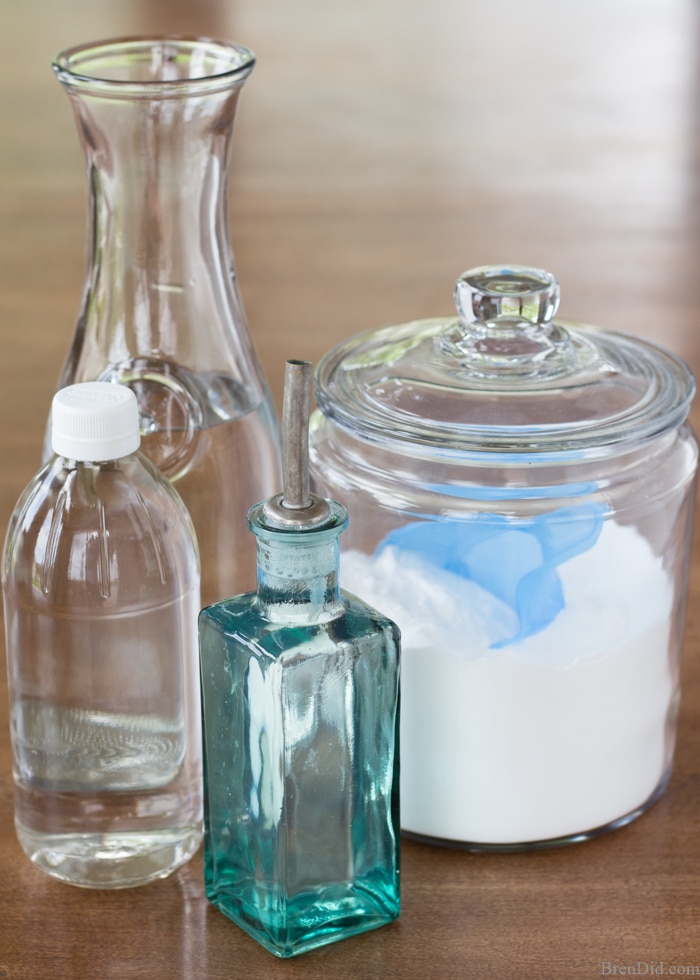 This post uses affiliate links.They don't cost you a thing and help us bring you all natural cleaning tutorials. Read more in Policies and Disclosures.
This post uses affiliate links.They don't cost you a thing and help us bring you all natural cleaning tutorials. Read more in Policies and Disclosures.
Hundreds of natural cleaning blog posts, books, and magazine columns recommend cleaning slow kitchen drains by pouring one cup of baking soda down the drain followed with one cup vinegar. I used this combination for many years then I began to doubt its effectiveness.
I decided to conduct an experiment to compare the drain cleaning abilities of vinegar & baking soda to another popular green cleaning solution -> dish detergent & hot water.
(Need to unclog a drain? Read How to Naturally Clean a Clogged Drain)
The Baking Soda and Vinegar Experiment
I conducted a simple experiment to compare two popular green cleaners when fighting a fat, oil, and grease drain clog(or FOG drain clog). FOG is the most common cause of slow drains and backup in home kitchens, learn more about FOG clogs.
- Step 1 – I used a tablespoon of butter to mimic a greasy FOG drain clog.

- Step 2 – I poured one-half cup of baking soda and one-half cup of vinegar into one bowl, and a cup of hot water (nearly boiling) mixed with 1 tablespoon of dish washing detergent into the second bowl.
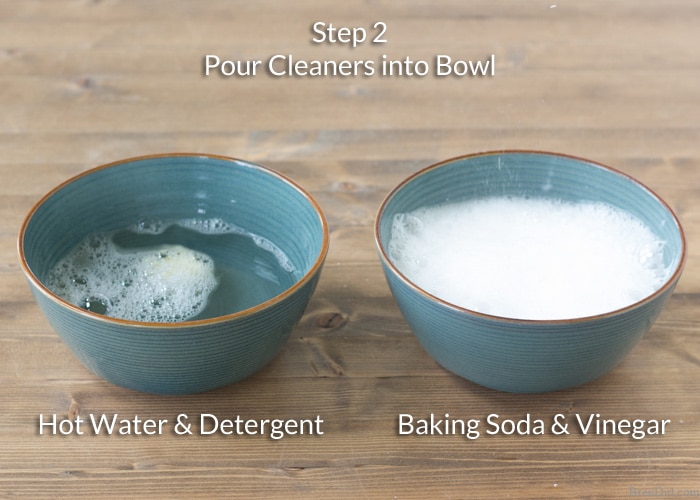
- Step 3 – I watched what happened to the greasy clog for 5 minutes. Here's what the bowls looked like at 30 seconds.
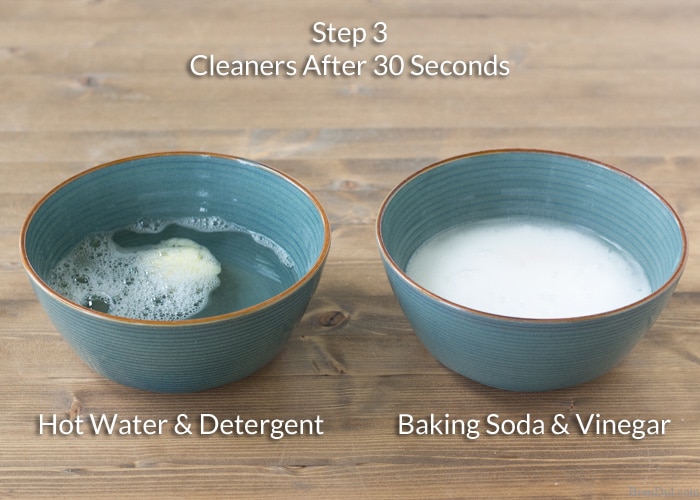
The Green Cleaning Results
After 5 minutes, the greasy clog in the bowl of hot water and detergent was completely melted and would have easily drained away. The greasy clog in the bowl of vinegar and baking soda was unchanged (although it was coated in vinegar and baking soda).
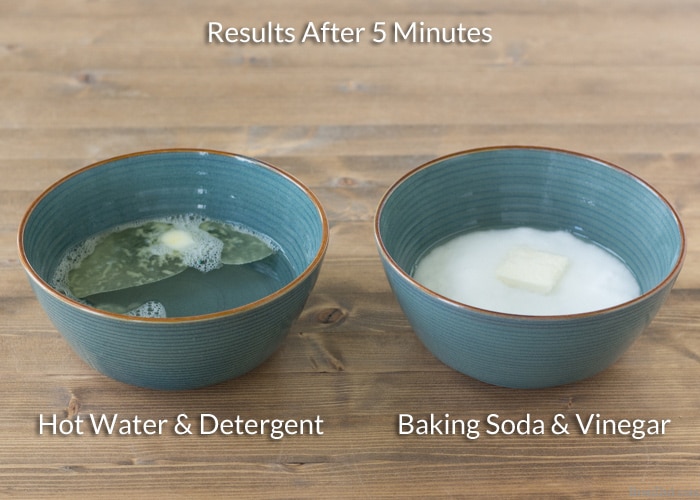
Here's what was left of the greasy FOG clogs (butter cubes) after the experiment.
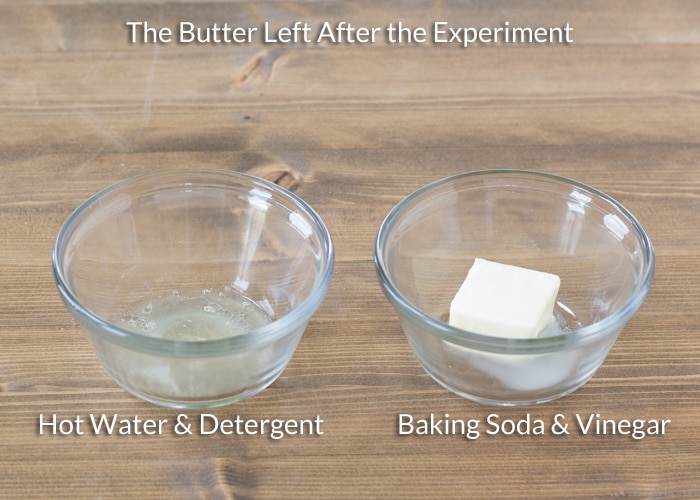
What I Learned
It turns out my high school chemistry teacher was right… the fizzy combination of baking soda & vinegar is INEFFECTIVE when fighting grease clogged drains.
Why? Baking soda is a basewhile vinegar is an acid, their chemical reaction produces water with a tiny amount of salt in it, not a fat destroying drain cleaner. Plus vinegar and baking soda are not surfactants, so they do not help water carry oil and grease away the same way that detergents can.
The hot water does a better job melting the FOG clog and gets a kick from the degreasing power of the detergent.
What about the pressure created?
Lots of readers ask about the pressure created during the vinegar/baking soda reaction and wonder if it will force a drain clog out. The answer is yes and no.
- Yes, when baking soda and vinegar are combined the chemical reaction produces carbon dioxide gas (CO2 ) which creates pressure in a closed container.
- No, the baking soda/vinegar reaction created in a drain/household plumbing system does not take place in a closed system so pressure can't build up enough to blast a clog out of the pipes.
You may have seen vinegar/baking soda experiment conducted in a closed container like a balloon or bottle. They're an impressive demonstration of the power of chemical reactions. However, it's important to note that these experiments take place in a sealed containerwhere the CO2 gas has nowhere to escape.
A household drain system is not a sealed container. From kitchen drain to sewer your pipes hold a much larger volume of liquid or gas than a balloon or bottle, so it would take a lot more CO2 to fill the pipes to a point where pressure builds up. Plus, the CO2 being created byt the baking soda/vinegar reaction can escape though the plumbing vent system, holes in your drain or drain cover, and/or spaces in the clog. It's not air tight!
The Hot Water Solution
Let me tell you a little secret: questioning the drain cleaning power of baking soda and vinegar is controversial. It gets people mad, very mad. I get emails and comments that are not appropriate to post on a PG website.
I'm sorry if you're upset, I really am. I was a baking soda/vinegar devotee for a long time. However, once I started researching green cleaning ingredients and bad cleaner combinations I realized that the trick was not doing me much good… and I was wastingbaking soda and vinegar that I could use to clean other things.
Why is Baking Soda and Vinegar Recommend as a Drain Cleaner?
Maybe the fun chemical reaction tricks our minds with all the bubbling, maybe companies like to sell more of their products, or maybe it is the hot water.
- When you look at baking soda + vinegar drain cleaning instructions you'll notice that they recommend following the baking soda/vinegar with nearly boiling water. As shown in the experiment above, extremely hot water does a great job melting FOG clogs.
- Bonus: the weight of the hot water creates pressure on the clog which can help loosen or move it (thanks to gravity).
Try the Experiment for Yourself
Still have doubts? The next time you have a slow or clogged drain, try reaching for hot water first. You may find out that it does a great job cutting through FOG clogs and you can save yourself some money on baking soda and vinegar
The Enzyme Solution
Have a difficult FOG clog that hot water doesn't solve or a drain clogged by hair? Try an enzyme drain cleaner such as Earth Enzymes Drain Openeror Biokleen Drain Gel.
- These eco-friendly drain cleaners contain enzymes and bacteria that eat through the organic material in the clog to clear your drain. (Green Gobbler Drain Clog Remover is another popular solution, it uses monosodium sulfate, a non-toxic acid, to remove drain gunk.)
More drain cleaning tips
4 Easy Way to Green Clean Drains
- Learn four ways to clean a clogged drain without calling a plumber or using nasty chemicals.
Green Cleaning Combinations to Avoid
- Learn more about green cleaning combination that are dangerous or do not work.
(If you would like more information about the chemical reaction while cleaning with baking soda & vinegar, click over to Everyday Einstein.)
Jason @BeardedOverland www.beardedadv.blogspot.com
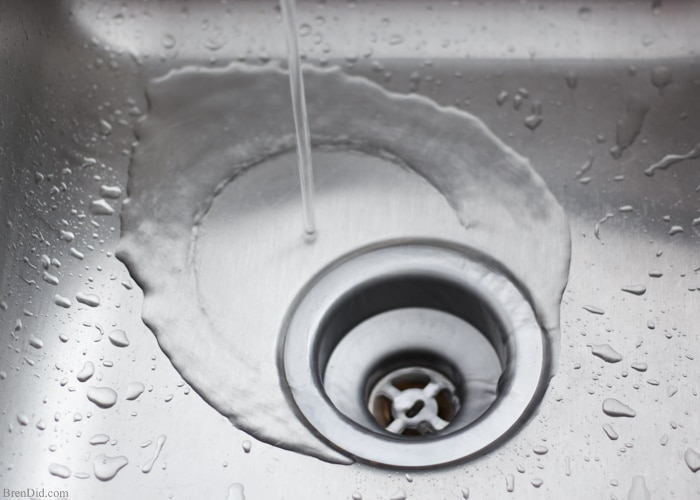
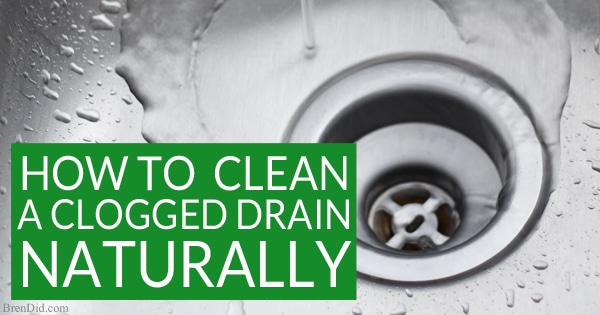
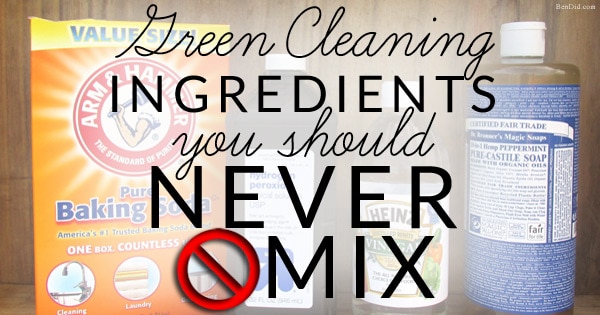




No comments:
Post a Comment